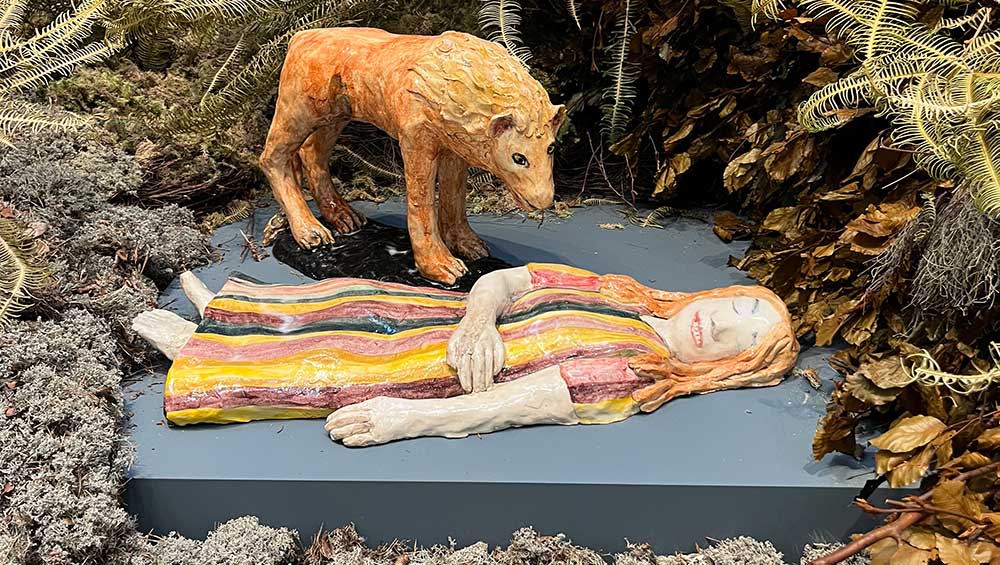
Installation view of Klara Kristalova (detail), Strange Clay: Ceramics in Contemporary Art, Hayward Gallery, London (26 October 2022 - 8 January 2023). Photo: Veronica Simpson.
Hayward Gallery, London
26 October 2022 – 8 January 2023
by VERONICA SIMPSON
It was not so long ago that the ceramic artist Sam Lucas was told, while studying at Cardiff School of Art in the late 1980s, that she had all the makings of a sculptor, were it not for her stubborn attachment to clay. According to her tutors, insisting on clay as her medium made her a “potter”, confined for ever to the realms of craft shops and artisan boutiques. What strange material hierarchies the art world used to be hobbled by. Not any more.
Strange Clay at the Hayward plants this medium most definitively in fine art’s terrain. It is a wonderful moment to celebrate that shift – since both Grayson Perry and Edmund de Waal, who feature here, used to describe themselves proudly as “potters”. Now they are the poster boys for two very different kinds of ceramic fine art, their work filling galleries, not to mention wealthy collectors’ homes, all over the world (with represention by Victoria Miro and Gagosian, respectively).
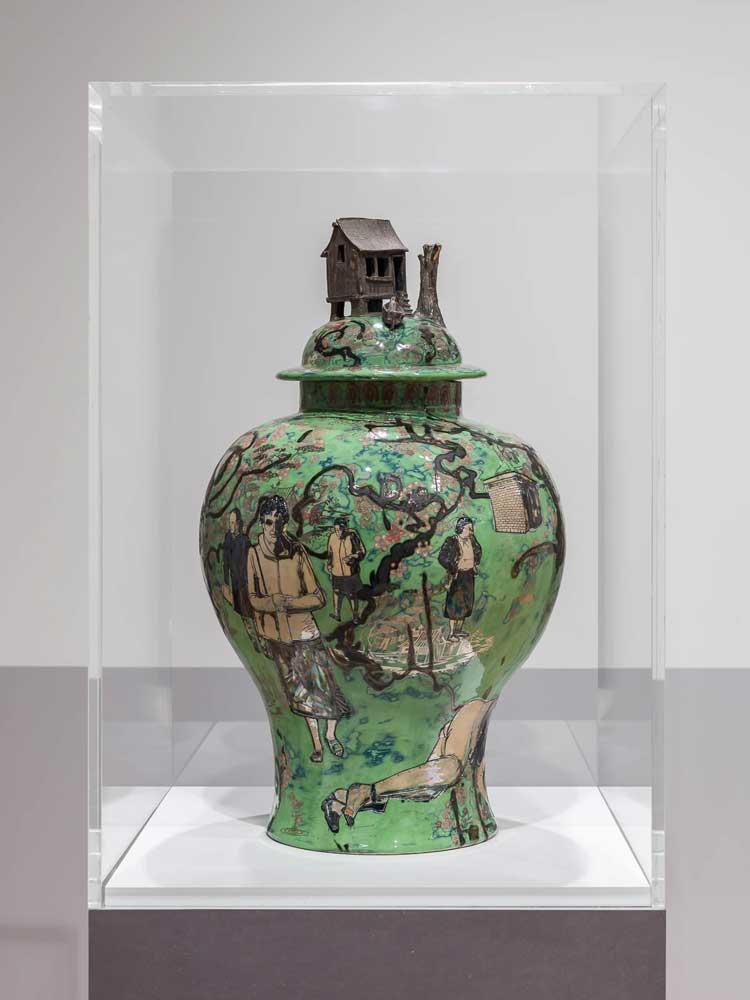
Installation view of Grayson Perry, Strange Clay: Ceramics in Contemporary Art, Hayward Gallery, London (26 October 2022 - 8 January 2023). Photo: Mark Blower.
Clay can be political, as Perry has amply demonstrated with his savagely accurate Hogarthian evocations of tribal behaviours and posturings along class and social divides. Curator Dr Cliff Lauson, who has gestated this show over four years, has chosen some early work of Perry’s to play up his pioneering provocations around gender rather than class, from the moment where his alter ego Claire (a glamorous, doll-like, female persona whom Perry alternates with his genial, low-key, everyman potter) started to appear on the pieces. As Lauson says: “Grayson was taking a traditional form and then completely usurping it. He challenged the norms while still throwing a pot.”
Here, too, are Lindsey Mendick, Leilah Babirye and Woody De Othello, who been taking clay into more political and provocative territory for a while, albeit covering very different terrain, enriched by their own perspectives. Unlike Perry’s plinth-topping, glass-encased pots and plates shown here, the works of the Ugandan-born, New York-based Babirye are fully free range, going from human scale to nearly 3 metres tall – monumental sculptures bringing qualities of dreadlocked shaman meets Easter Islander totem meets African mask. For her figures, the clay is combined with an assortment of other materials that some would define as “rubbish” - old bicycle tyres become hair, bike chains are woven into a kind of crown. That choice of discarded materials is a conscious evocation of the Ugandan slur for queer and trans people, abasiyazi, a term more normally used to denote the inedible fibres of sugar cane. By building these majestic, brooding figures out of materials that some would see as worthless, she is celebrating those “discarded” qualities and questioning wider values.
There are 23 artists here, showcasing the huge diversity of style, subject matter, technique and treatment, and experience afforded by clay. Expect the unexpected is the phrase that springs to mind for this exuberant show, filled as it is with fantastical forms, uncanny creatures, unlikely shapes and unfamiliar scales.
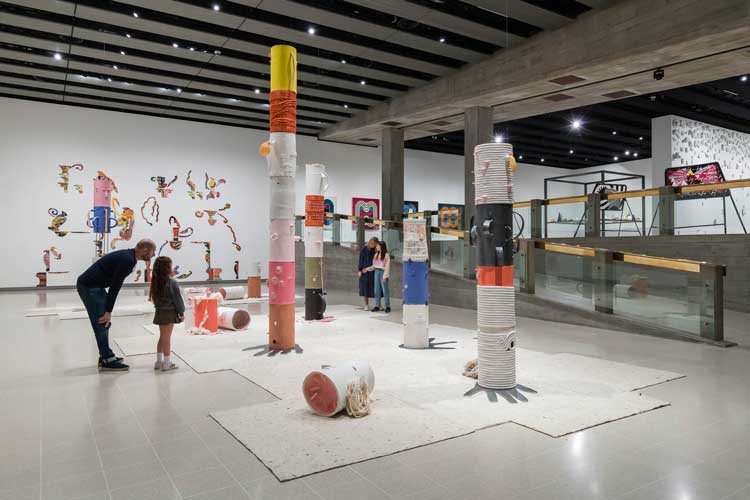
Installation view of Betty Woodman and Jonathan Baldock, Strange Clay: Ceramics in Contemporary Art, Hayward Gallery, London (26 October 2022 - 8 January 2023). Photo: Mark Blower. Courtesy the Hayward Gallery.
It is just as well that Lauson has found artists whose work positively exults in the monumental spaces of this big, brutalist, concrete gallery. They have used the building well. You would think that programming the Hayward’s cavernous first gallery would be a stretch, but no. This aircraft hangar of a space is fully peopled with Jonathan Baldock’s totem pole-strewn installation, Facecrime. Stacked ceramic cylinders, buckets and bowls, in pale or candy colours are interspersed with unlikely materials (wool, rope, basketry and glass) and forms – including an array of body parts. It is a pantomime/burlesque assembly: one tall cylinder of coiled clay flattens a large metal hand to the floor, while its top section features a glossy silicone breast and several pink, protruding tongues. It is accompanied by a softly saucy soundtrack of splurts, murmurings and giggles. This introduction sets the tone well for the playfulness and irreverence of the rest of the show.
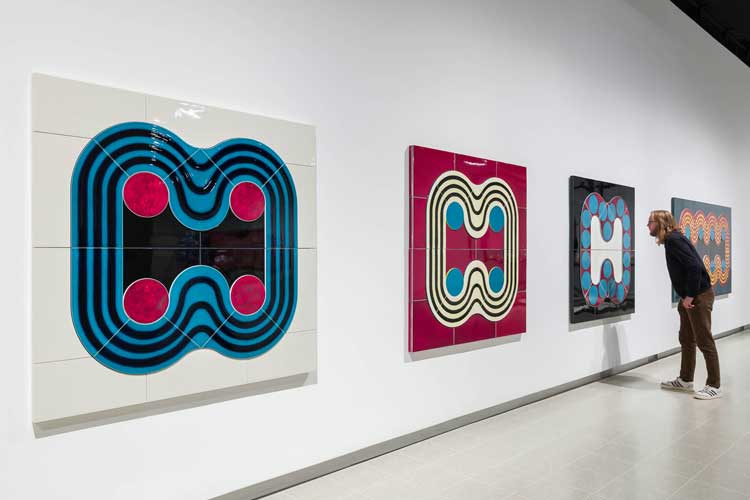
Installation view of Lubna Chowdhary, Strange Clay: Ceramics in Contemporary Art, Hayward Gallery, London (26 October 2022 - 8 January 2023). Photo: Mark Blower. Courtesy the Hayward Gallery.
Betty Woodman’s colourful, neo-classical urns, crests, jugs and finials, in glazed earthenware, are splayed in both flat and three-dimensional form across the far wall for her House of the South (1996) installation. Meanwhile, up on the mezzanine floor, we find the calmly absorbing geometries and architectural scale of Lubna Chowdhary’s huge wall tiles from her Sign series (2021-22) juxtaposed with the brightly coloured and cartoonish patterned ceramic windscreens presented on metal frames at car-window height, by Emma Hart.
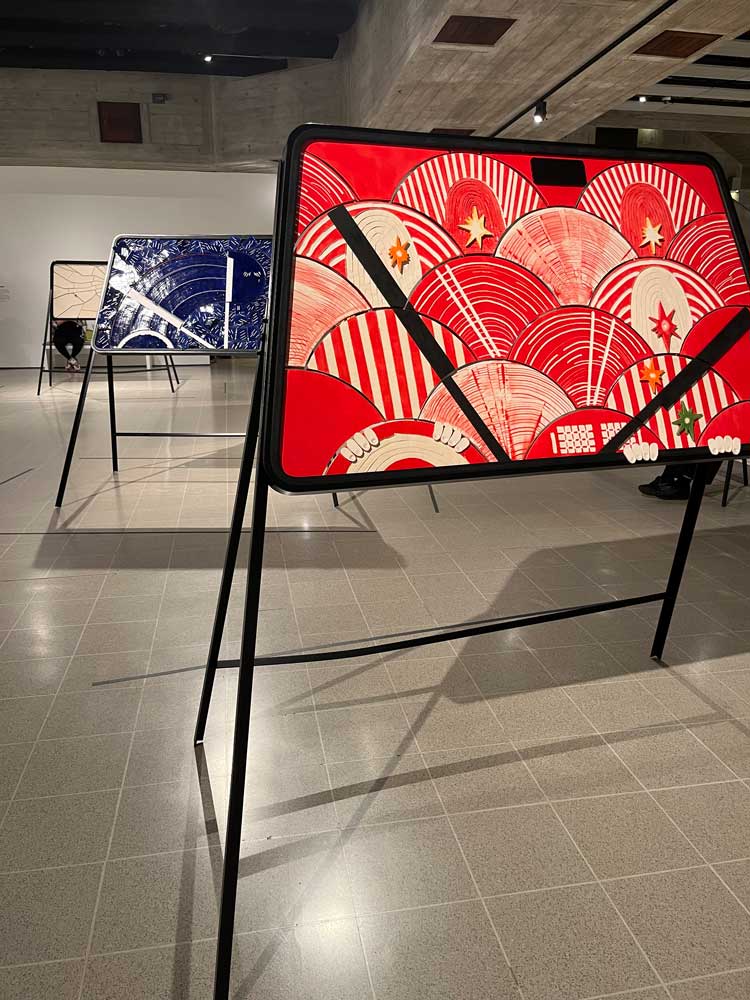
Installation view of Emma Hart, Strange Clay: Ceramics in Contemporary Art, Hayward Gallery, London (26 October 2022 - 8 January 2023). Photo: Veronica Simpson.
.-Photo_-Mark-Blower.-Courtesy-the-Hayward-Gallery.jpg)
Installation view of Shahpour Pouyan, Strange Clay: Ceramics in Contemporary Art, Hayward Gallery, London (26 October 2022 - 8 January 2023). Photo: Mark Blower. Courtesy the Hayward Gallery.
Contrasting nicely with Chowdhary’s supersized tile works is a variety of pleasing forms by Shahpour Pouyan, arranged on shelves around a square, shed-sized steel display structure. The piece, called My Place is the Placeless (2017), was inspired by Pouyan taking a DNA test in 2013 and learning that his ancestors came from 33 different countries, including his native Iran. He set about researching the indigenous architecture of each region and has represented his meditations here in forms that express essential roof structures of each culture’s architecture; a beautiful installation, well worth lingering over.
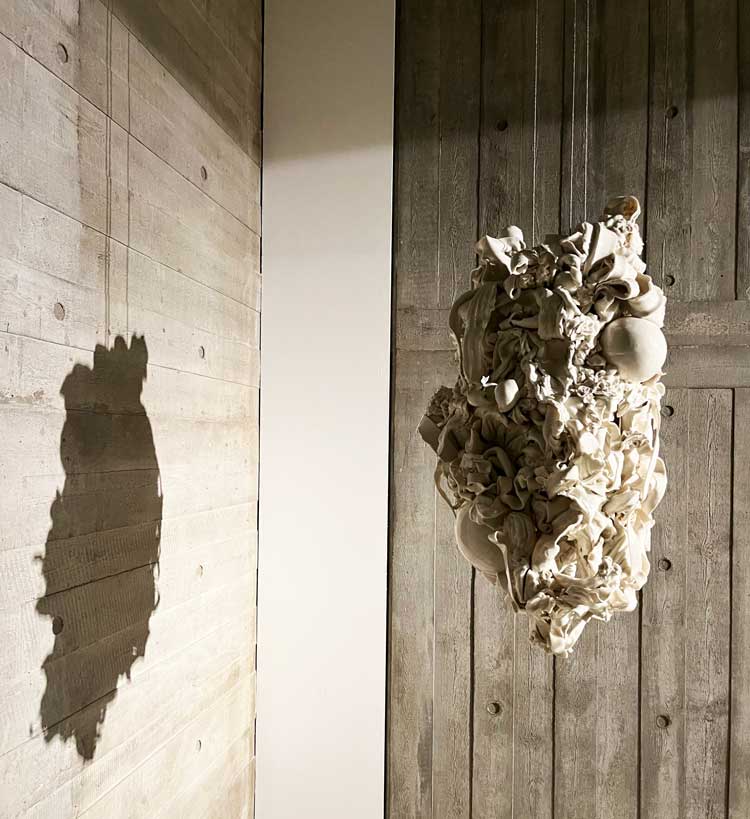
Installation view of Rachel Kneebone, Strange Clay: Ceramics in Contemporary Art, Hayward Gallery, London (26 October 2022 - 8 January 2023). Photo: Veronica Simpson.
Rachel Kneebone is something of a contemporary clay celebrity (with representation by White Cube). Her gleaming, bone-white porcelain works featuring twisting amalgamations of vines, ribbons and limbs look fabulous against a simple, white wall (as with Quill, 2021), but even more texturally rich against the Hayward’s iconic boardmarked concrete, as with one dangling piece near the exit.
Continuing up to the first-floor galleries, we are met with the unearthly sight of one of the Peruvian-born, Berlin-based artist David Zink Yi’s giant squids. It lies glistening on the floor, surrounded by what appears to be a pool of dark, inky liquid, looking as if it could slither down the stairs at any moment.
-installation-view-V-Simpson.jpg)
Installation view of David Zink Yi, Strange Clay: Ceramics in Contemporary Art, Hayward Gallery, London (26 October 2022 - 8 January 2023). Photo: Veronica Simpson.
This is part of a series Yi has been making on the deep-sea-dwelling giant squid (Architeuthis), which grows to more than 14 feet in length, and lives so deep in the ocean that it had never been witnessed alive until a film captured it in 2014: previously it had been sighted only when it washed up onshore, dead. As Yi says in the wall text: “I found it fascinating that there is a species in this world we can only encounter dead.” The extraordinary, slick look to this creature has been achieved with a unique mix of oxides, earth and minerals.
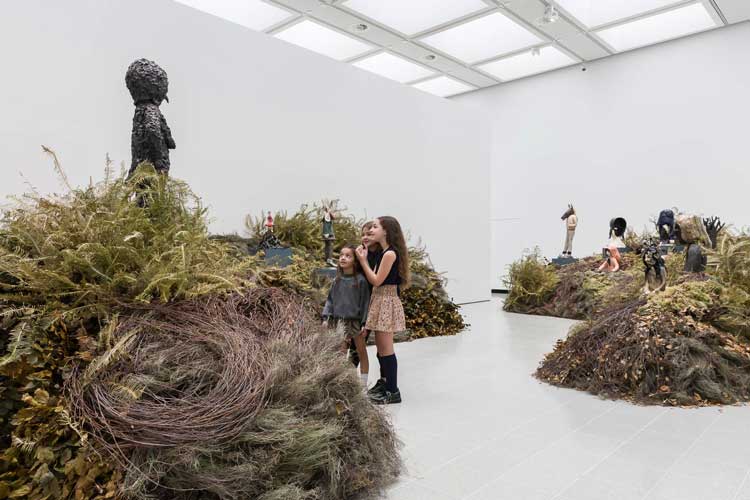
Installation view of Klara Kristalova, Strange Clay: Ceramics in Contemporary Art, Hayward Gallery, London (26 October 2022 - 8 January 2023). Photo: Mark Blower. Courtesy the Hayward Gallery.
A wonderful scent emanates from the room-sized installation in the next gallery, from Klara Kristalova, Far from Here, in which 18 stoneware figures are perched around a hilly landscape formed of dried vegetation. These figures are partway through transforming, from human to animal, insect to plant and vice versa. Gloss and matt finishes combine to seductive effect.
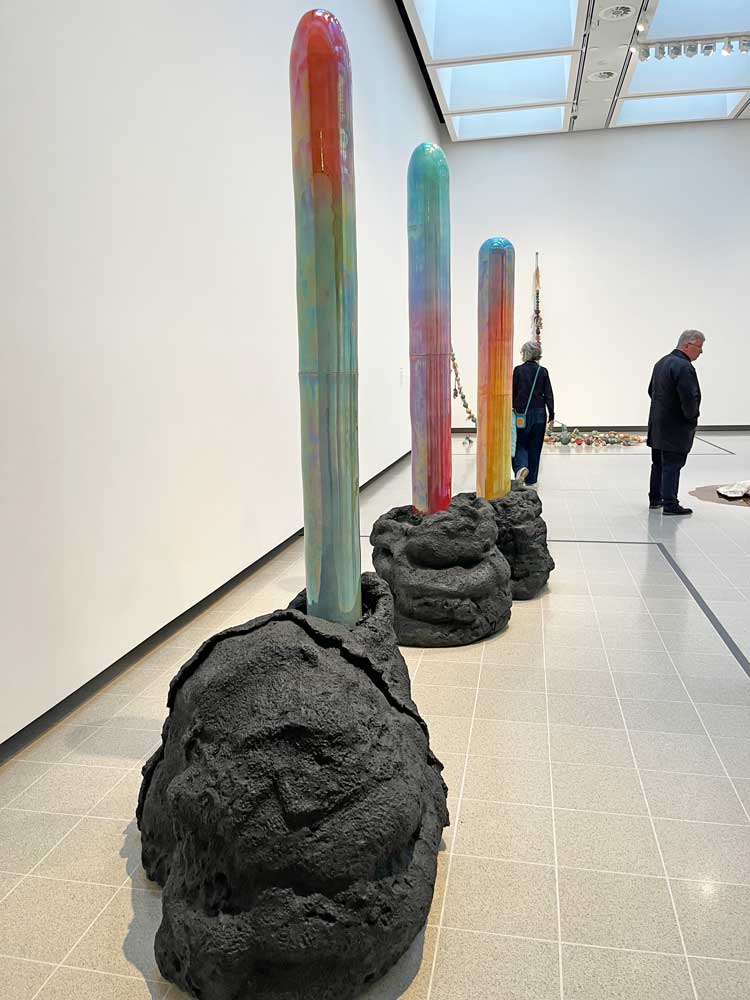
Installation view of Salvatore Arancio, Strange Clay: Ceramics in Contemporary Art, Hayward Gallery, London (26 October 2022 - 8 January 2023). Photo: Veronica Simpson.
Speaking of seduction, Salvatore Arancio’s installation is a mouthwatering array of slim columns in gorgeous, iridescent hues, surging up from black, volcanic lumps of unglazed clay. Called It Was Only a Matter of Time Before We Found the Pyramid and Forced it Open, it is inspired by the volcanic geology of his native Sicily and his belief in nature as a spiritual force.
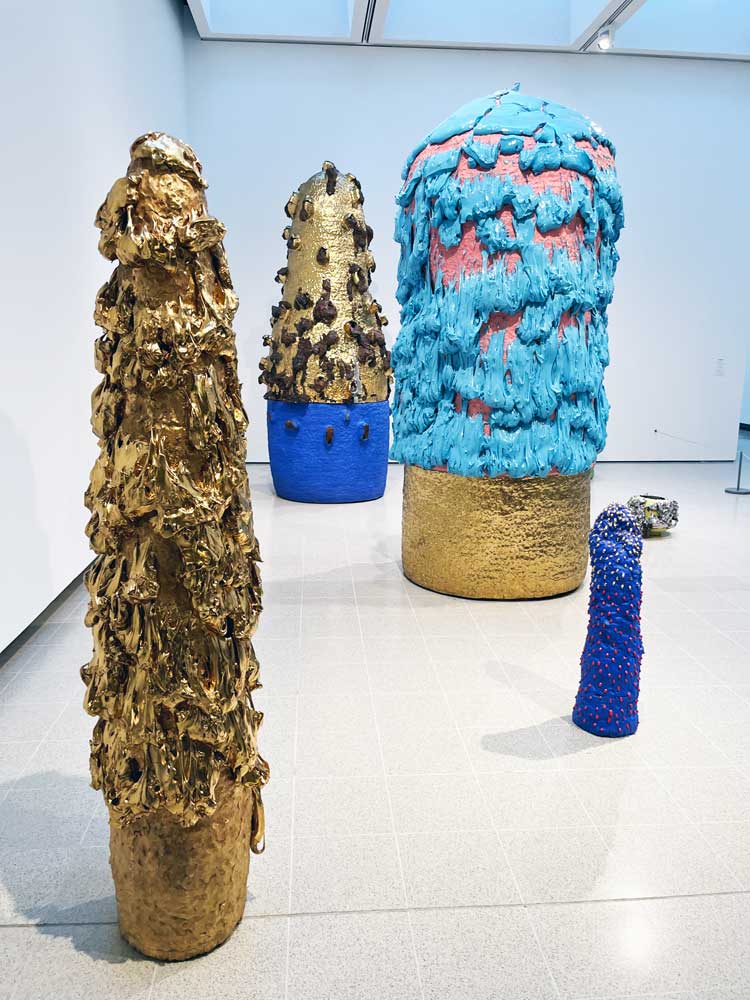
Installation view of Takuro Kuwata, Strange Clay: Ceramics in Contemporary Art, Hayward Gallery, London (26 October 2022 - 8 January 2023). Photo: Veronica Simpson.
The forces of nature are very evident in the installation by Takuro Kuwata. In his reinterpretations of Japanese tea bowls (chawan), he inverts these usually smooth, elliptical shapes into colourful, shaggy and shiny, often human-sized forms that, in their vivid and different personalities make me think of the characters in Sesame Street – if they were to be cast in ceramic. His techniques here include kairagi - a kind of glaze that results in cracked and mottled surfaces – and ishihaze, in which stones are embedded in the clay, causing ruptures in the surface as they explode under the heat of the kiln.
-installation-2-V-Simpson.jpg)
Installation view of Edmund de Waal, Strange Clay: Ceramics in Contemporary Art, Hayward Gallery, London (26 October 2022 - 8 January 2023). Photo: Veronica Simpson.
I am surprised and delighted anew by the installation from De Waal, whose work I have been following for more than two decades – which means I thought I knew what to expect: usually, assorted small and luminous, porcelain vessels grouped poetically together. This work, Atmosphere (2014), was made for a show at the Turner Contemporary in 2014, but it adds a new dimension to his usual presentation by suspending these showcases from the ceiling. Here, the way they hover across a large window from the Royal Festival Hall is inspired – the small, regular, porcelain forms in their sleek oblong frames echo the modernist window patterns in the minimalist concrete building across the way, creating a dialogue on translucence and pattern across the eras and between two art forms. The point of them being suspended, however, is to force the viewer to look up into the vitrines, which vary in opacity, and notice the shift in atmosphere as the light changes.
.jpg)
Installation view of Lindsey Mendick (detail of work Till Death Do Us Part, 2022, Strange Clay: Ceramics in Contemporary Art, Hayward Gallery, London (26 October 2022 - 8 January 2023). Photo: Veronica Simpson.
From this meditation on light we go, down the stairs, to some very dark matter. Mendick’s Till Death Do Us Part takes its title from Madonna’s song chronicling her difficult relationship with actor Sean Penn (a song that is tinnily audible from some transistor radio somewhere in this domestic nightmare). Lauson says he was particularly excited to see the reactions to this work, which was commissioned for this show. He says: “I’ve been speaking to Lindsey for several years, since before the pandemic. Her practice has developed and many more are familiar with her work. It brings in elements of biography and identity, familial relationships, using the medium of clay to tell these stories.” The installation Lauson describes as “an exploded flat or house”, with each tableau presenting a kind of David Lynch-type stage set of either nostalgia or horror – in each one battles are being fought by assorted ceramic vermin or creatures that are repellent to humans. There are mice, rats, moths, spiders, caterpillars; there is even an octopus emerging from the loo. Says Lauson: “The vermin are at war with each other, and the house is taking a beating for it. It’s all about the tensions of the domestic.”
That just about nails the essence of this show: how a domestic material, so utterly commonplace and quotidian, can be transformed through artistry, technique and imagination into something that vibrates on a totally different level.